Approximately 25% of traditional search engine volume is expected to drop by 2026, making way for generative engines.
This means that more and more online sessions will begin with an AI-powered interface instead of the familiar search bars. For marketers, this change signals more than just a platform shift but also a mindset change.
If SEO is about ranking high, generative engine optimization (GEO) is about being referenced more accurately and contextually. It’s no longer enough to write content that ranks. We now need to create content that can be understood by machines, retrieved in milliseconds, and quoted as credible inside AI-generated responses.

What Is Generative Engine Optimization (GEO)?
The newly emerged term refers to the process of creating and structuring content specifically for AI-powered platforms, like ChatGPT, Perplexity, and Google’s Search Generative Experience (SGE), which generate direct answers. Unlike search engine optimization, where your goal is to rank higher on search engine results pages (SERPs), GEO is all about making your content legible to large language models (LLMs).
The same principles that work for SEO now apply to AI systems.
It’s called GEO (Generative Engine Optimization) – optimizing your content so ChatGPT, Claude, Gemini & Perplexity actually cite and recommend your brand.
The tactics are different, but the opportunity is massive. pic.twitter.com/SS76kWrEI1
— seoplus+ (@seopluscanada) June 19, 2025
AI engines don’t just crawl a website looking for relevant keywords, but parse context, intent, and generate answers based on relevance and source credibility. This makes us create content that is:
- Factually Consistent and Semantically Rich: Prioritize content that stays on-topic and provides clear, well-supported facts in a natural language.
- Structurally Clean and Easy to Extract: Structure information in digestible formats, using clear headings, lists, and direct answers. This will help AI identify the key takeaways.
- Backed by Clear Signals of Authority and Trust: Include author credentials and citations to signal that your content is worthy of citation.
How Does GEO Differ from Traditional SEO?
The difference between GEO vs. SEO goes far beyond where your content appears.
| Aspect | Traditional SEO | GEO |
| Primary Goal | Rank high on search engine result pages (SERPs) | Be cited within AI-generated answers |
| Content Focus | Keyword-driven and long-form | Conceptual clarity and semantic relevance |
| User Interaction Target | Click-throughs and page visits | Mentions and trusted citations |
| Formatting Style | Comprehensive articles and keyword usage | Structured, extractable snippets (FAQs, lists, Q&A) |
| Optimization Priority | Search engine algorithms | Language model comprehension and source trust |
The shift from rankings to references is a big leap, but it’s just the beginning. Here’s how the two stack up in key areas:
- Keyword-Focused Optimization vs. Semantic Understanding
SEO still relies heavily on mapping content to high-volume keywords and variants. GEO, on the other hand, rewards conceptual coverage, i.e., how well your content addresses a topic holistically and uses natural language that aligns with how people actually ask questions in AI chat. Instead of chasing keyword density, GEO pushes you to focus on clarity, definitions, and logically structured information.
- Click-Through Optimization vs. Citation Optimization
In SEO, writing strong meta titles and descriptions is key to boosting CTR. In GEO, your goal is the mentions and not the clicks. AI platforms summarize content and cite it within their answer instead of sending the users to a list of links. So, you need to create content that earns trust and deserves attribution, even if users never land on your page.
- Long-Form Content vs. Extractable Answer Formats
Long-form content is still relevant and important, but AI doesn’t read it from top to bottom. Instead, it looks for snippets to understand and reuse through its resources. Bullet points, FAQs, and clearly formatted sub-sections are far more valuable than dense paragraphs.
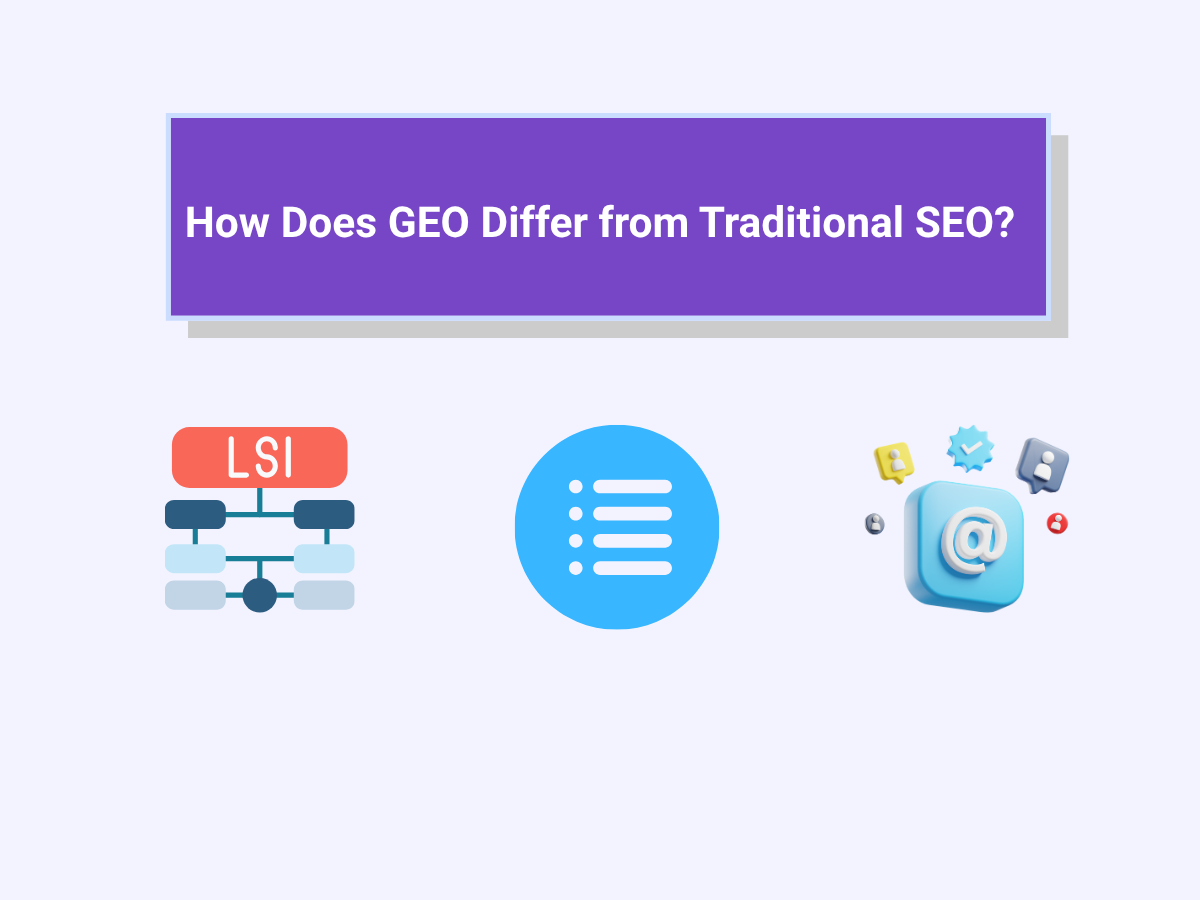
GEO vs AEO vs LLMO: What’s the Difference?
As search continues to evolve, marketers are seeing acronyms multiply with GEO, AEO, and LLMO leading the way. The distinctions may not be obvious at first glance, yet understanding the nuances is how you future-proof your content for traditional and AI-powered searches.

While they all focus on increasing discoverability in non-traditional search environments, their core mechanisms and end goals differ.
- GEO aims to make your content legible and citable by AI engines.
- AEO focuses on answering searcher intent directly through structured data.
- LLMO is about feeding content to the foundational models themselves, often before it’s ever queried in real-time.
What Is Answer Engine Optimization (AEO)?
AEO is the practice of optimizing website content for the direct answer boxes and featured snippets across platforms, search engines like Google, Bing, and even voice assistants.
— ClickSoup (@Click_Soup) June 20, 2024
The main idea behind AEO is providing structured and concise answers to predictable user questions. Therefore, it often relies on schema markup, FAQ sections, and definition-based formatting.
This strategy is still very much tied to search engines, not large language models. Its strength lies in structured formatting and intent-based keyword targeting, not semantic depth or conversational phrasing.
What Is Large Language Model Optimization (LLMO)?
Large Language Model Optimization (LLMO) is a newer, more technical approach that focuses on how your content is represented within the training datasets or retrieval pipelines of large language models like GPT-4, Claude, or Gemini.
While GEO focuses on real-time retrieval from live sources, LLMO emphasizes pre-training exposure and dataset-friendly structuring. It involves making sure your content is publicly accessible, clearly attributed, and frequently cited, so that it’s more likely to appear in the LLM’s learned knowledge or be referenced during generation.
LLMO also factors in machine readability, canonical tagging, and publishing practices that align with how models are trained, not just how they crawl. Think of it as playing the long game: if your content is authoritative and consistently referenced across the web, it’s more likely to be embedded in the LLM’s conceptual map of a topic.
Quick Comparison Table: GEO vs AEO vs LLMO
| Optimization Type | Primary Goal | Target Platform | Core Techniques | Citation Format |
| GEO | Be cited in real-time AI answers | ChatGPT, Perplexity, Google SGE | Structured answers, E-E-A-T, machine legibility | Inline attribution or linked sources |
| AEO | Appear in search engine answer boxes | Google SERP, Bing, voice search | Schema markup, FAQs, direct answers | Featured snippets or answer panels |
| LLMO | Influence LLM outputs via training data | GPT-4, Claude, Gemini | Dataset-friendly formatting, canonical content, and reputation | Implicit citation (no linked sources) |
Each strategy plays a different role in the new content visibility landscape. GEO is also about local citation building, AEO is about predictable search visibility, and LLMO is about foundational knowledge representation.
Statistical Landscape and Market Trends
Generative engines reshape how users access and interact with content online. Recent usage patterns, platform growth, and engagement metrics all point toward a significant behavioral shift. Businesses that once relied solely on traditional SEO are more prone to losing a portion of traffic if they don’t optimize for generative engines.
Current Adoption Metrics and Market Share Data
The rise of AI-powered interfaces has been anything but subtle. Apart from the drop in traditional searches, here are a couple of other changes leading the charge and coming soon:
- Perplexity.ai has achieved remarkable adoption, with over 15 million active monthly users.
- ChatGPT saw a 33% increase in its user base, resulting in up to 400 million active users from December 2024 to February 2025.
- 13.14% of all Google queries triggered AI Overviews in March 2025, a dramatic increase from just 6.49% in January 2025. This highlights how quickly answer-style, AI-generated search results are taking hold.
It’s also worth noting that the use of AI engines varies through multiple stages of the user journey and differs based on purpose:
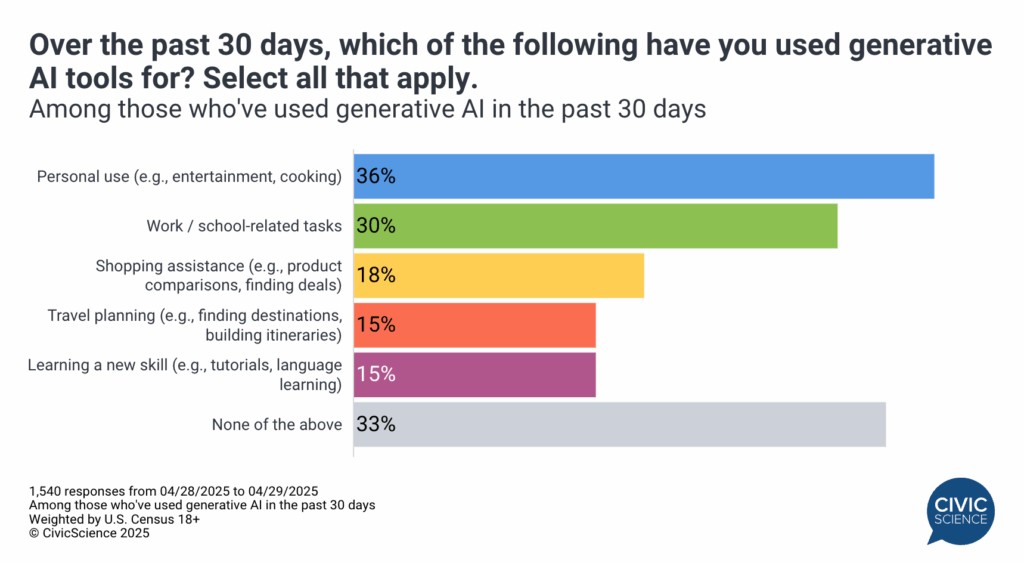
Demographic and Geographic Adoption Patterns
- Generative search platforms are most popular among Gen Z and younger millennials, with 43% of U.S. adults ages 18-29 having used ChatGPT compared to just 6% of those 65+.
- Regionally, Asia-Pacific is the region seeing the fastest generative AI adoption, fueled largely by mobile-first usage.
Future Forecasts and Evolution Predictions
- As AI-native content indexing rises, expect algorithms to favor machine-readable formats and semantic clarity, which can directly impact visibility.
- Citation-driven models in platforms like ChatGPT and Claude are likely to evolve, increasing the value of source attribution and domain authority in AI-generated responses.
These statistics validate a clear trajectory: traditional search isn’t disappearing, but it’s evolving, and generative engines are becoming a dominant front door to the web. The smart content strategies of tomorrow focus on being machine-legible, factually robust, and primed for citation.
Platform-Specific GEO Strategies
The core principles of generative engine optimization are clarity, authority, and structure. Yet, each AI platform has its unique content preferences, citation logic, and technical nuances. Understanding those is how businesses get to decide the direction they want to evolve and become trusted by the artificial intelligence search engines.
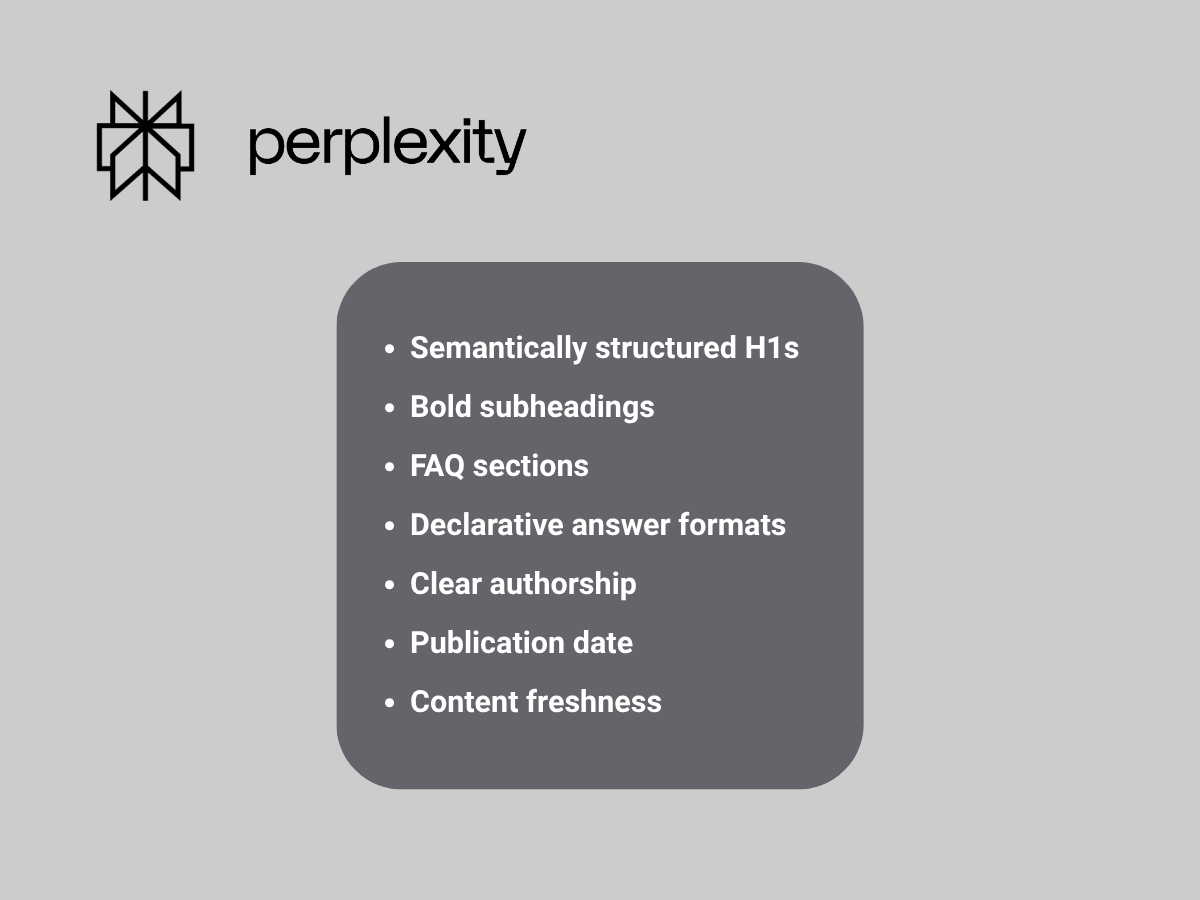
How Perplexity Interprets and Cites Content
Perplexity.ai stands out for its real-time retrieval-based architecture, meaning it doesn’t rely solely on pre-trained models. As you type your inquiry, it pulls live content from the web using APIs, search indexes, and its crawlers, thus generating up-to-date answers.
Real-Time Source Integration Preferences
Perplexity favors fast-loading pages with semantically structured H1s, bold subheadings, FAQ sections, and declarative answer formats to questions. This type of content is easier for the system to parse and quote in real time.
Citation Format and Attribution Requirements
Citations should appear as hover-over links or footnotes that directly point to the data sources. To increase citation chances, ensure your page has clear authorship, publication date, and direct answers high up on the page.
Content Freshness and Authority Signals
Since it pulls live data, Perplexity favors recently updated content. The platform favors displayed content update history, publishing timestamps, and links to third-party sources that boost your trust factor.
Optimization Tip: Treat your content like a mini knowledge base—concise, sourced, and cleanly structured.
Google SGE (Search Generative Experience) Optimization
Google SGE brings generative answers directly into the search experience, often as part of blended SERPs. Unlike Perplexity, it’s deeply intertwined with Google’s traditional ranking signals and web ecosystem.
Google’s SGE (Generative AI in Search) expands to more than 120 new countries and territories!
+ many improvements!
💬 Simplified follow-up questions
🗣 New languages added
🔣 More accurate translations
📚 Interactive definitionsG’s announcement: https://t.co/zstcphvKQJ #SEO pic.twitter.com/mkbyf6xuKj
— Charly Wargnier (@DataChaz) November 9, 2023
Integration With Traditional Google Ranking Factors
Your existing SEO performance still matters. Content that ranks well traditionally is more likely to be surfaced in SGE. That includes mobile usability, Core Web Vitals, and adherence to Google’s E-E-A-T principles.
Featured Snippet Enhancement for SGE Inclusion
If your content already appears in a featured snippet, it’s far more likely to be referenced or even paraphrased in the generative response. Use clear definitions, bullet points, and well-marked schema to boost snippet eligibility.
Local SEO Considerations for SGE Responses
SGE integrates local pack data and often blends conversational answers with map listings. To appear in those responses, maintain accurate listings through consistent local citation building and leverage structured data like LocalBusiness schema.
Optimization Tip: View SGE as “SEO-plus”. All your current SEO work still applies, but now needs added semantic clarity and scannable structure.
ChatGPT and OpenAI Platform Optimization
ChatGPT’s core model (GPT-4-turbo) is trained on a mixture of licensed data, public websites, and content up to its knowledge cut-off. However, when plugins or browsing tools are active (e.g., in ChatGPT Pro), it can access live web pages for sourcing.
Training Data Considerations and Content Accessibility
While you can’t directly “submit” content for inclusion in the model, public, well-linked content is more likely to be included during training runs. Canonical tags, strong internal linking, and domain authority all boost inclusion odds.
Conversational Format Preferences
GPT models favor content written in a question-answer format, natural language, and instructional style. Guides, how-tos, and explainer pages tend to be easier for the model to summarize and serve.
Factual Accuracy and Source Verification
OpenAI emphasizes trustworthy outputs. This means that by linking to credible sources and showcasing your expert authorship, you increase your chances of being paraphrased or cited.
Optimization Tip: Write for humans, but edit with the model in mind. Make every answer clear, extractable, and logically sequenced.
Emerging Platforms: Claude, Gemini, and Others
Beyond the dominant players, newer generative engines are gaining traction and bringing new technical constraints and content priorities to the table.
Some platform-specific content preferences include:
- Claude (Anthropic): Emphasized safety and factuality, favoring sources with transparent sources and ethical standards.
- Gemini (Google DeepMind): Leans on multimodal capabilities like text, images, and video, meaning content that integrates media is more likely to be featured on the platform.
Future optimization opportunities:
As these engines mature, expect more tools that allow publisher-level control (e.g., opt-in datasets). Being an early adopter in formatting and structuring content for these models could give you a competitive edge as their usage grows.
How to Optimize Content for Generative Engines
Optimizing for generative engines means that each page should be crafted with intent:
- What is the main question this content answers?
- How clearly is that information expressed?
- What signals support its authority?
Additionally, technical integrity plays a bigger role than most realize. Apart from being, your content also needs to be crawlable, fetchable, and unambiguous. That includes how your metadata is written, how your tags are organized, and how your pages resolve across devices and bots.
Is Your Brand Ready for AI Search?
-
Get instant access to our AI Brand Optimization Checklist + Brand Control Framework — a powerful bundle to help you:
✔️ Audit your brand’s visibility in LLMs like ChatGPT & Perplexity
✔️ Identify blind spots, brand proxies, and AI misinterpretations
✔️ Apply the 4-part Brand Control Quadrant to guide your strategy
Built for CMOs, brand teams, and digital strategists.z
Let’s start with metadata, which is the first touchpoint between your content and any generative engine.
Optimize Metadata for AI Interpretability
Metadata is not only a Google-friendly label. For generative engines, it acts as the first signal of topical clarity, guiding LLMs in understanding what your content is about and whether it matches the user’s intent.

- Optimize Metadata for AI Interpretability: Metadata is more than a Google-friendly label. For generative engines, it acts as the first signal of topical clarity, guiding LLMs in understanding what your content is about and whether it matches the user’s intent.
- Use Question-Based Meta Titles in Natural Language: Instead of stuffing titles with partial keywords, reframe them as full, natural-sounding queries (e.g., “What Is Lifecycle Marketing?”). AI engines interpret these as intent-rich signals and are more likely to associate your page with relevant prompts.
- Write Clear, Direct Meta Descriptions that Reflect the Answer: Metadata should act as a one-sentence summary, directly answering the title’s question. This improves extractability and gives the AI a precise anchor for quoting or summarizing.
- Focus on Clarity, Instead of Keyword Stuffing: Generative models reward semantic match over keyword density. A clear, jargon-free summary outperforms keyword-heavy fluff when it comes to LLM interpretation.
- Add Open Graph and Twitter Card tags: These tags not only improve visual previews on social and plugin-based tools but also reinforce content themes for AI scrapers and third-party engines pulling metadata.
- Use Canonical Tags to Prevent Duplication: Duplicate or conflicting URLs confuse crawlers and reduce the likelihood of accurate attribution. Proper canonicalization ensures your preferred version is the one that gets cited.
Improve Site Architecture for LLM Crawlability
AI engines cannot cite what they cannot reach, so site architecture is one of the key pillars of answer engine optimization. Having a well-structured site gives language models a clearer path to understand how your content connects with the search inquiries.
- Link Each Page From at Least One Crawlable Page: Orphan pages that don’t have internal links get missed by LLMs and search crawlers. Make sure every page is accessible from at least one other crawlable entry point on your site.
- Keep Site Structure Flat (Max 3 Levels Deep): Deep hierarchies increase the risk of crawl inefficiency. Flatten your structure so that important pages can be reached within two or three clicks from the homepage.
- Use Breadcrumbs and HTML Sitemaps: Breadcrumbs help models understand how content is categorized, while HTML sitemaps ensure discoverability even if crawlers hit a dead end.
- Group Pages by Semantic Topic: Clustering related content under clear topical hubs helps generative engines infer expertise across related themes, not just single keywords.
- Keep URLs Clean and Descriptive: URLs should reflect the page’s purpose with human-readable text. Avoid dynamic parameters or unclear slugs that make it harder for engines to predict page context.
Ensure Pages Are Fully Indexed and Fetchable
Even the most well-written, AI-friendly content won’t show up in generative engines if it’s blocked from being seen. GEO requires a fetch-first mindset, meaning it should be visible and ready to be indexed by bots and AI crawlers alike.
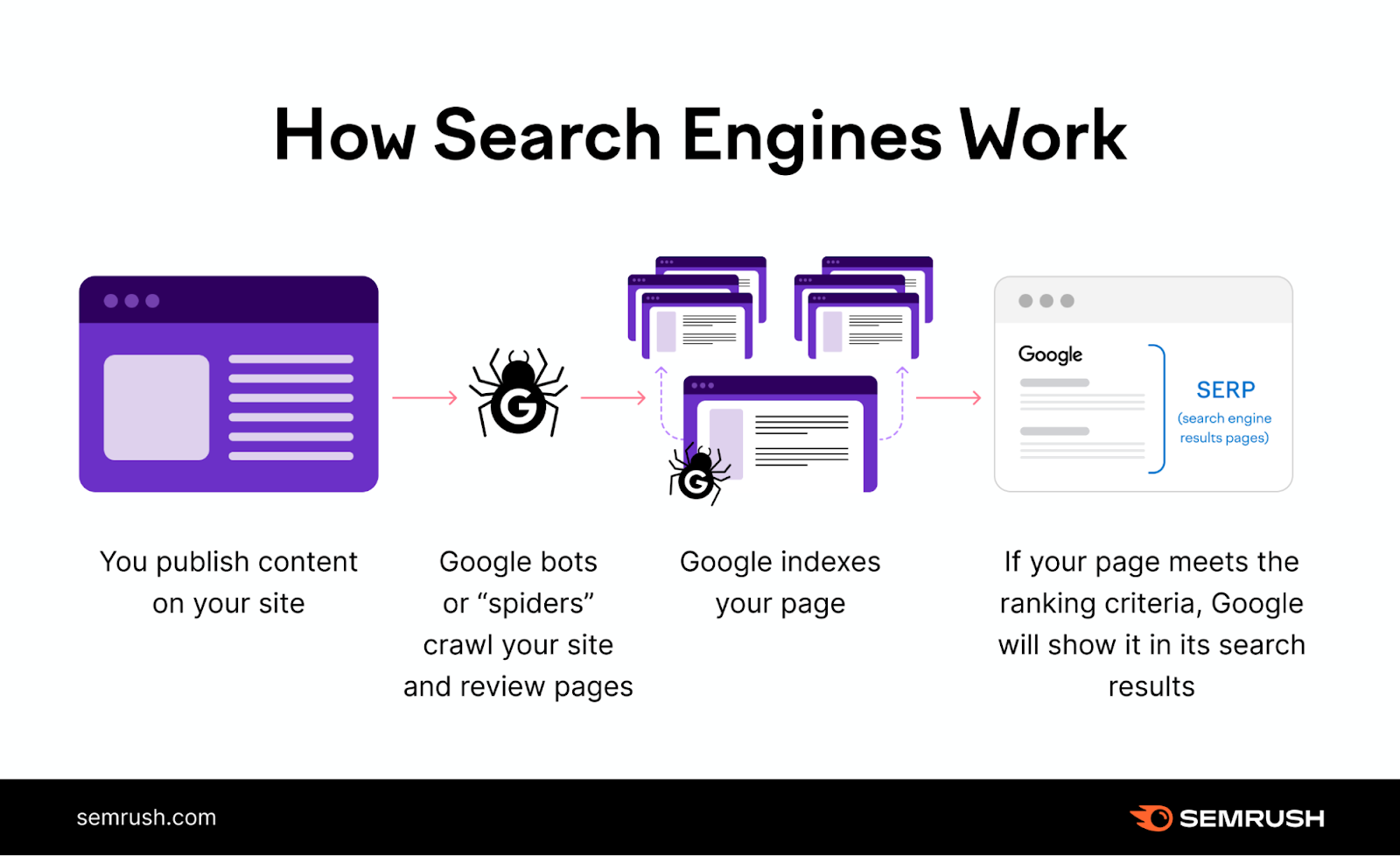
- Confirm Indexing via GSC and Bing Webmaster Tools: Regularly check Google Search Console and Bing Webmaster Tools to verify which pages are indexed and identify crawl issues early.
- Avoid Noindex, Disallow, or JS-Heavy Content: Pages blocked by robots.txt or marked with noindex tags won’t be discoverable. Similarly, JavaScript-rendered content often fails to load correctly for AI crawlers unless explicitly pre-rendered.
- Test Rendering Using Fetch-As-Google and LLM Previews: Use tools like Google’s “URL Inspection” to see how bots render your content. If it’s blank or broken in the preview, it’s unlikely to be quoted or understood by an LLM.
- Use Robot Meta Tags that Support Snippet Generation: Tags like max-snippet:-1 or nosnippet can prevent your content from being cited. Ensure your robots meta directives are GEO-friendly and allow full snippet generation where needed.
Strengthen E-E-A-T Signals (Experience, Expertise, Authority, Trust)
AI platforms are trained to prioritize sources that demonstrate depth, transparency, and authority, especially in sensitive or fact-based topics. This suggests that strengthening your Google E-E-A-T signals will help with both SEO and AI systems.
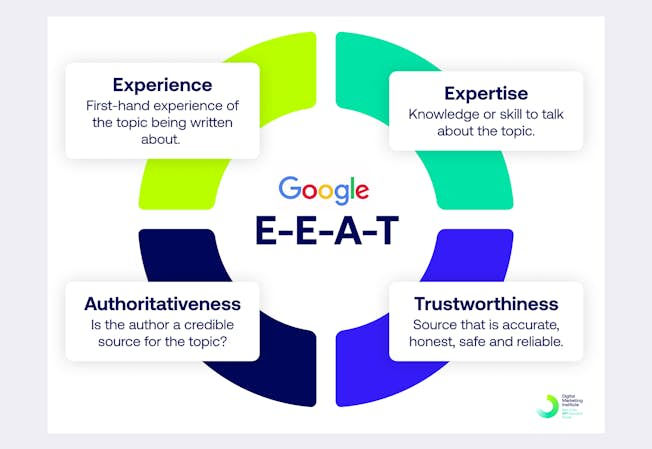
- Link to Author Bios with Credentials: Connect articles to real people with relevant expertise. Include author bios that highlight qualifications, experience, and industry background.
- Show Dates, Citations, and Update History: Display the original publish date, latest update, and source references where appropriate. This gives both users and AI engines confidence that the content is current and factually grounded.
- Display Trust Indicators (Privacy Policy, Ownership): Footer links to your privacy policy, terms of service, and company information help confirm that your site is legitimate for users and crawlers evaluating brand trustworthiness.
- Get Cited by Authoritative Third-Party Domains: The more links and references your content receives from respected publications and industry experts, the stronger your perceived authority becomes in the eyes of generative models.
Build Topical and Backlink Authority Around LLM-Queried Themes
Generative engines don’t look at one isolated page, but evaluate how your domain engages with the topic at large. That’s why building a network of high-quality, interlinked content around core queries is one of the most effective long-term GEO strategies.
- Publish Clustered Content Around Key Queries: Instead of one comprehensive guide, create a content hub with multiple articles that cover related subtopics. This reinforces topical relevance and gives LLMs more angles to pull context from.
- Use Contextual Internal Linking: Connect your articles using keyword-rich anchor text that mirrors the way real users phrase their queries. This helps models follow semantic connections and understand page intent.
- Gain Backlinks From Authoritative, Topic-Relevant Sites: External validation still matters. Secure backlinks from high-trust sites in your industry to elevate your domain authority, especially from sources already cited in AI outputs.
- Share Content on Q&A and AI-Indexed Platforms: Websites like Quora, Reddit, and other niche forums are often indexed by AI tools. Contribute useful and relevant answers linking back to your content to increase your chances of being referenced in AI-generated summaries.
Preparing for the Future of Search
GEO content strategy is no longer something businesses can treat as an afterthought. Once a trend, it’s now become the logical next step in the evolution of search. From structured content and semantic clarity to platform-specific optimization, staying visible now means being understood and trusted by machines.
At Andava Digital, we help businesses develop future-ready websites optimized for human audiences and AI crawlers. Whether you need a full website SEO audit service, support with local searches, or a long-term GEO strategy, our AI knowledge and experience can help you reach the next milestones.
Let’s build a strategy that not only ranks but gets cited, trusted, and remembered. Talk to our team now!